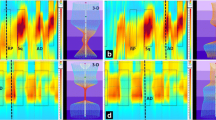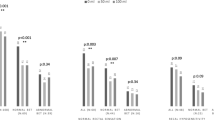Abstract
Purpose
The purpose of this study was to evaluate anorectal function in different subgroups of patients with irritable bowel syndrome (IBS), including those with mixed bowel habits.
Materials and Methods
Sixty-six IBS patients selected according to Rome III criteria (39 female and 27 male patients; mean age, 41.5 ± 15.4) and 20 subjects in the control group (13 female and 7 male patients; mean age, 41.4 ± 13.7) were examined. The IBS patients were divided into three subgroups according to bowel movement pattern: patients with constipation (27%), patients with diarrhea (27%), and patients with mixed bowel habits (46%). Anorectal manometry and rectal distension test were performed using a four-lumen water-perfused catheter with a polyethylene balloon.
Results
No significant differences in manometric parameters between the subgroups of IBS patients and the control group were found, except for pelvic floor dyssynergia (PFD), which was more frequent in all subgroups of IBS (41% of patients) than in controls (5% of subjects) (p < 0.01). Lower rectal pain threshold was observed particularly in IBS patients with diarrhea and mixed bowel habits (p < 0.01).
Conclusion
Manometric parameters characterizing anal sphincter function are not correlated with the predominant bowel movement pattern in IBS. The features of PFD are significantly more frequent in all subgroups of IBS patients than in controls, suggesting that, in general, IBS patients show changes in the mobility of the pelvic floor. Hypersensitivity to rectal distension is commonly observed in IBS, but it does not seem to be a highly specific marker of the disorder.
Similar content being viewed by others
References
Mertz H, Naliboff B, Munakata J, Niazi N, Mayer EA (1995) Altered rectal perception is a biological marker of patients with irritable bowel syndrome. Gastroenterology 109:40–52
Prior A, Maxton DG, Whorwell PJ (1990) Anorectal manometry in irritable bowel syndrome: differences between diarrhoea and constipation predominant subjects. Gut 31:458–462
Azpiroz F, Enck P, Whitehead WE (2002) Anorectal functional testing: review of collective experience. Am J Gastroenterol 97:232–240
Mertz H, Naliboff B, Mayer EA (1999) Symptoms and physiology in severe chronic constipation. Am J Gastroenterol 94:131–138
Kempinski R (2005) Anorectal manometry in patients with constipation of different origin. Gastroenterol Pol 12:201–207
Ragnarsson G, Hallbook O, Bodemar G (2001) Abdominal symptoms and anorectal function in health and irritable bowel syndrome. Scand J Gastroenterol 36:833–842
Delvaux M (2002) Do we need to perform rectal distention tests to diagnose IBS in clinical practice? Gastroenterology 122:2075–2078
Coremans G, Azpiroz F, Collins S, Dapoigny M, Muller-Lissner SA, Pace F, Smout A, Stockbrugger RW, Whorwell PJ (2002) The rectum: a window to irritable bowel syndrome? Digestion 65:238–249
Bouin M, Plourde V, Boivin M, Riberdy M, Lupien F, Laganiere M, Verrier P, Poitras P (2002) Rectal distention testing in patients with irritable bowel syndrome: sensitivity, specificity, and predictive values of pain sensory thresholds. Gastroenterology 122:1771–1777
Ragnarsson G, Hallbook O, Bodemar G (1999) Abdominal symptoms are not related to anorectal function in the irritable bowel syndrome. Scand J Gastroenterol 34:250–258
Oettle GJ, Heaton KW (1986) “Rectal dissatisfaction” in the irritable bowel syndrome. A manometric and radiological study Int J Colorectal Dis 1:183–185
Kwan CL, Davis KD, Mikula K, Diamant NE (2004) Abnormal rectal motor physiology in patients with irritable bowel syndrome. Neurogastroenterol Motil 16:251–263
Awad RA, Martin J, Guevara M, Ramos R, Noguera JL, Camacho S, Santiago R, Ramirez JL, Toriz A (1997) Defaecography in patients with irritable bowel syndrome and healthy volunteers. Int J Colorectal Dis 12:91–94
Prior A, Read NW (1993) Reduction of rectal sensitivity and post-prandial motility by granisetron, a 5 HT3-receptor antagonist, in patients with irritable bowel syndrome. Aliment Pharmacol Ther 7:175–180
Mulak A, Paradowski L (2007) Anorectal function in the irritable bowel syndrome depending on patients gender and age. Gastroenterol Pol 14:107–110
Sun WM, Read NW (1989) Anorectal function in normal human subjects: effect of gender. Int J Colorectal Dis 4:188–196
Awad RA, Camacho S, Martín J, Rios N (2006) Rectal sensation, pelvic floor function and symptom severity in Hispanic population with irritable bowel syndrome with constipation. Colorectal Dis 8:488–893
Penning C, Steens J, van der Schaar PJ, Kuyvenhoven J, Delemarre JB, Lamers CB, Masclee AA (2001) Motor and sensory function of the rectum in different subtypes of constipation. Scand J Gastroenterol 36:32–38
Voderholzer WA, Neuhaus DA, Klauser AG, Tzavella K, Muller-Lissner SA, Schindlbeck NE (1997) Paradoxical sphincter contraction is rarely indicative of anismus. Gut 41:258–262
Awad RA, Martin J, Cal y Major M, Noguera JL, Ramos R, Amezcua C, Camacho S, Santiago R, Ramirez JL, Castro J (1998) Transrectal ultrasonography: relationship with anorectal manometry, electromyography and sensitivity tests in irritable bowel syndrome. Int J Colorectal Dis 13:82–87
Palmer BV, Lockley WJ, Palmer RB, Kulinskaya E (2002) Improvement in irritable bowel syndrome following ano-rectal surgery. Int J Colorectal Dis 17:402–411
Distrutti E, Salvioli B, Azpiroz F, Malagelada JR (2004) Rectal function and bowel habit in irritable bowel syndrome. Am J Gastroenterol 99:131–137
Steens J, Van Der Schaar PJ, Penning C, Brussee J, Masclee AA (2002) Compliance, tone and sensitivity of the rectum in different subtypes of irritable bowel syndrome. Neurogastroenterol Motil 14:241–247
Mulak A (2003) Testing of visceral sensitivity. J Physiol Pharmacol 54S(Suppl 4):55–72
Zar S, Benson MJ, Kumar D (2006) Rectal afferent hypersensitivity and compliance in irritable bowel syndrome: differences between diarrhoea-predominant and constipation-predominant subgroups. Eur J Gastroenterol Hepatol 18:151–158
Harraf F, Schmulson M, Saba L, Niazi N, Fass R, Munakata J, Diehl D, Mertz H, Naliboff B, Mayer EA (1998) Subtypes of constipation predominant irritable bowel syndrome based on rectal perception. Gut 43:388–394
Schmulson M, Chang L, Naliboff B, Lee OY, Mayer EA (2000) Correlation of symptom criteria with perception thresholds during rectosigmoid distension in irritable bowel syndrome patients. Am J Gastroenterol 95:152–156
Tremolaterra F, Villoria A, Azpiroz F, Serra J, Aguadé S, Malagelada JR (2006) Impaired viscerosomatic reflexes and abdominal-wall dystony associated with bloating. Gastroenterology 130:1062–1068
Villoria A, Azpiroz F, Soldevilla A, Perez F, Malagelada JR (2008) Abdominal accommodation: a coordinated adaptation of the abdominal wall to its content. Am J Gastroenterol 103:2807–2815
Park JH, Baek YH, Park DI, Kim HJ, Cho YK, Sohn CI, Jeon WK, Kim BI, Rhee PL (2008) Analysis of rectal dynamic and static compliances in patients with irritable bowel syndrome. Int J Colorectal Dis 23:659–664
Conflict of interest
The authors declare that they have no conflict of interest.
Author information
Authors and Affiliations
Corresponding author
Additional information
The results of this study have been presented as a poster (poster 224) at the 2009 Neurogastroenterology and Motility Joint International Meeting held in Chicago on August 27–30, 2009.
Rights and permissions
About this article
Cite this article
Mulak, A., Paradowski, L. Anorectal function and dyssynergic defecation in different subgroups of patients with irritable bowel syndrome. Int J Colorectal Dis 25, 1011–1016 (2010). https://doi.org/10.1007/s00384-010-0950-5
Accepted:
Published:
Issue Date:
DOI: https://doi.org/10.1007/s00384-010-0950-5




